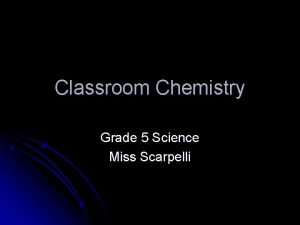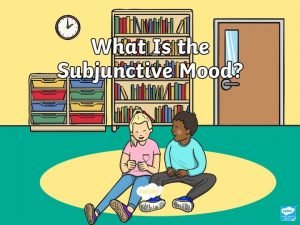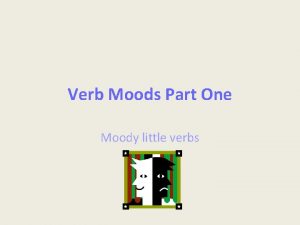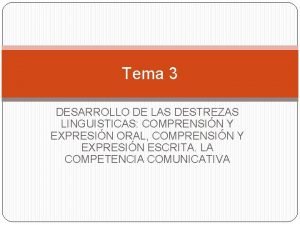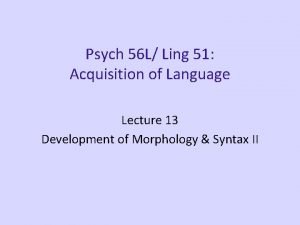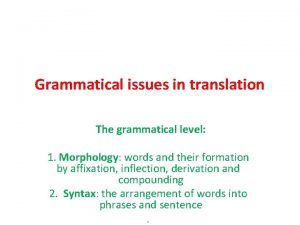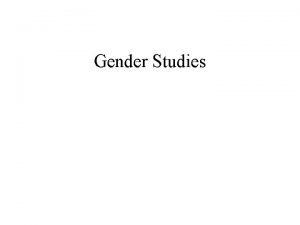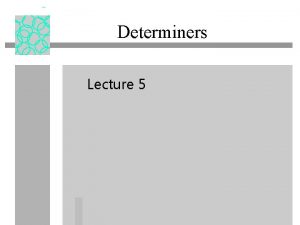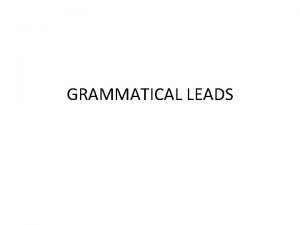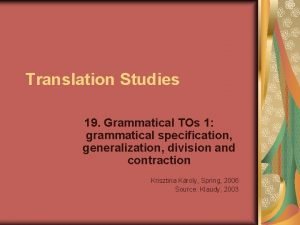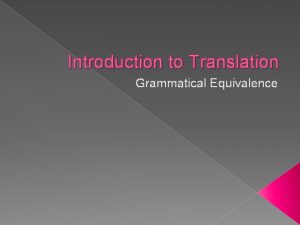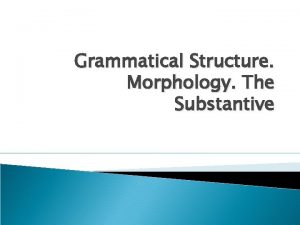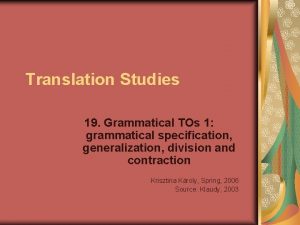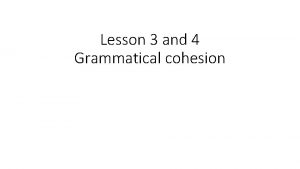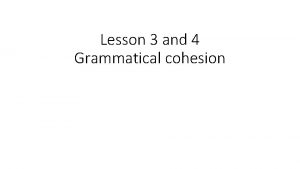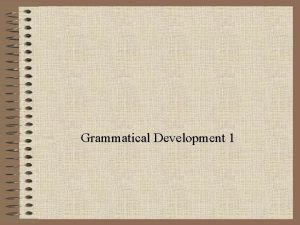Getting Grammatical The Classroom Grade Level 8 Gender
















- Slides: 16

Getting Grammatical

The Classroom Grade Level: 8 Gender: Boys (45%) & Girls (55%) SES: Eligible for Free Lunch: 9% Eligible for Reduced Lunch: 3% Location: Madrona School Edmonds, WA Races: American Indian: 1%, Asian: 10%, Hispanic: 9%, Black: 2%, White: 66%, Two or more races: 12% Academics: 74% of students are proficient in reading and/or math

Grammar Issues Students are not attempting to use colons in their writing. Students are not giving specific enough answers on their close reading worksheets. Example: Q: 7. How important is Joby to the army? In what ways does the drummer boy control the mood of the troops? Student Answer: Joby is the heart of the army. Specific Answer: Joby is the heart of the army: his steady drumming gives the men strength and courage.

Today’s Standard CCSS. ELA-LITERACY. L. 8. 1 Demonstrate command of the conventions of standard English grammar and usage when writing or speaking.

Learning Target I can, by the end of the period, accurately write an original compound sentence with an explanatory statement (clauses separated by a colon) by analyzing examples of this type of explanatory compound sentence.

Refresher: Independent Clauses It contains a SUBJECT and a VERB, expresses a complete thought and can stand on its own. Example of an Independent Clause: Monica will be going to Nicaragua over Christmas break.

Refresher: Compound Sentences A compound sentence consists of two independent clauses connected by a comma and a coordinating conjuction (ex: for, and, not, but, or, yet or so), a semicolon or a colon. Ex: Joe waited for the train, but the train was late.

Compound Sentence with an Explanatory Statement (clauses separated with a colon) General Statement (idea) : specific statement (example) (independent clause) A compound sentence with clauses separated by a colon *Colons are a sign to the reader that something important/explanatory is coming up first -The colon signals that the second clause will further explain the clause. The first clause gives a general statement or idea The second clause gives specific information that helps explain the first clause.

Ex: The upper school schedule will change next year: periods will be longer than they are this year. The first clause informs the reader of a general schedule change. The second clause gives a specific example of a change. The two clauses are separated by a colon. The colon signals that more explanation and/or something important will follow.

Example A lizard never worries about losing its tail: it can always grow another. Two independent clauses (both have subject and verb) The two clauses are separated by a colon. -The first clause is a general statement about why a lizard never worries about losing its tail. The second clause gives a specific reason why a lizard never worries.

Example Superman has extraordinary powers: He flies like a bird and has X-ray vision. 1. UNDERLINE the subject and the verb 2. CIRCLE the independent clauses 3. PUT A BOX around the colon. *If students missed something, go over the steps as a class. *Discuss as a class what is happening in the first clause and what is happening in the second clause.

Pick a Sentence Pick a sentence on the sheet. Underline the subject and verb Circle the independent clause Put a box around the colon Write an analysis of the first clause. What is the general statement? Write an analysis of the second clause. How does the specific statement in the second clause help explain the first clause?

Share with a Peer!

Who would like to share with the class?

Write your Own Compound Sentence with an Explanatory Statement (clauses separated by a colon) Use the examples on your sheet as a guide! Example: You should always follow this rule: research your topic thoroughly. My version: You should always follow this rule: treat your body like a temple. Or write an original sentence!

Share with a Peer/ The Class
 The secret to getting ahead is getting started
The secret to getting ahead is getting started Strategic gender needs and practical gender needs
Strategic gender needs and practical gender needs Btech smart classes
Btech smart classes Classroom rules for second grade
Classroom rules for second grade Classroom rules grade 6
Classroom rules grade 6 Classroom chemistry grade 5
Classroom chemistry grade 5 Subjunctive english
Subjunctive english Imperativ
Imperativ Hình ảnh bộ gõ cơ thể búng tay
Hình ảnh bộ gõ cơ thể búng tay Grammatical signals meaning
Grammatical signals meaning Examples of grammatical competence
Examples of grammatical competence Grammatical meaning and lexical meaning
Grammatical meaning and lexical meaning Examples of grammatical competence
Examples of grammatical competence Paragraph with parallelism
Paragraph with parallelism Paula congdon
Paula congdon Bổ thể
Bổ thể





